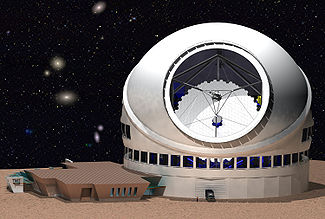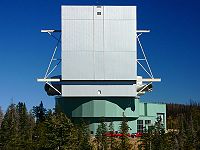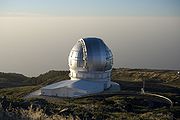
Extremely large telescope
Encyclopedia
An extremely large telescope (ELT) is an astronomical observatory featuring a telescope
with an aperture of more than 20 m diameter when discussing reflecting telescopes of optical wavelengths including ultraviolet
(UV), visible, and near infrared
wavelengths. Among many planned capabilities, ELTs are planned to increase the chance of finding Earth-like planets around other stars. Telescopes for other wavelengths can be much larger physically, such as the 100 meter (109 yards) aperture on the Green Bank Telescope
for radio wavelengths, but different wavelengths like radio have different capabilities.
These telescopes have a number of features in common, in particular the use of a segmented primary mirror
(similar to the existing Keck telescopes
), and the use of high-order adaptive optics
systems. See also the List of largest optical reflecting telescopes for other large finished telescopes.
Although ELTs are large, they have smaller apertures than the aperture synthesis
on many large optical interferometers. However, they have much more light collecting ability, along with other advantages.
* The LBT telescope baseline is via aperture synthesis.
The Very Large Telescope
is also of note, with 4 × 8.2 m, 4 × 1.8, and 1 × 2.61, all on separate mounts but in one building for interferometry.
Funded construction
Projects
Some of these projects are completed, or merged into ongoing ELTs.
Telescope
A telescope is an instrument that aids in the observation of remote objects by collecting electromagnetic radiation . The first known practical telescopes were invented in the Netherlands at the beginning of the 1600s , using glass lenses...
with an aperture of more than 20 m diameter when discussing reflecting telescopes of optical wavelengths including ultraviolet
Ultraviolet
Ultraviolet light is electromagnetic radiation with a wavelength shorter than that of visible light, but longer than X-rays, in the range 10 nm to 400 nm, and energies from 3 eV to 124 eV...
(UV), visible, and near infrared
Infrared
Infrared light is electromagnetic radiation with a wavelength longer than that of visible light, measured from the nominal edge of visible red light at 0.74 micrometres , and extending conventionally to 300 µm...
wavelengths. Among many planned capabilities, ELTs are planned to increase the chance of finding Earth-like planets around other stars. Telescopes for other wavelengths can be much larger physically, such as the 100 meter (109 yards) aperture on the Green Bank Telescope
Green Bank Telescope
The Robert C. Byrd Green Bank Telescope is the world's largest fully steerable radio telescope and the world's largest land-based movable structure. It is part of the National Radio Astronomy Observatory site at Green Bank, West Virginia, USA. The telescope honors the name of the late Senator...
for radio wavelengths, but different wavelengths like radio have different capabilities.
These telescopes have a number of features in common, in particular the use of a segmented primary mirror
Segmented mirror
A segmented mirror is an array of smaller mirrors designed to act as segments of a single large curved mirror. The segments can be either spherical or asymmetric . They are used as objectives for large reflecting telescopes...
(similar to the existing Keck telescopes
Keck telescopes
The W. M. Keck Observatory is a two-telescope astronomical observatory at an elevation of near the summit of Mauna Kea in Hawai'i. The primary mirrors of each of the two telescopes are in diameter, making them the second largest optical telescopes in the world, slightly behind the Gran Telescopio...
), and the use of high-order adaptive optics
Adaptive optics
Adaptive optics is a technology used to improve the performance of optical systems by reducing the effect of wavefront distortions. It is used in astronomical telescopes and laser communication systems to remove the effects of atmospheric distortion, and in retinal imaging systems to reduce the...
systems. See also the List of largest optical reflecting telescopes for other large finished telescopes.
Although ELTs are large, they have smaller apertures than the aperture synthesis
Aperture synthesis
Aperture synthesis or synthesis imaging is a type of interferometry that mixes signals from a collection of telescopes to produce images having the same angular resolution as an instrument the size of the entire collection...
on many large optical interferometers. However, they have much more light collecting ability, along with other advantages.
ELTs
Top three ELTs that are funded with two smaller but completed large telescopes for comparison (background yellow). In the early 2000s, all three targeted completion in 2018, although this slipped to 2022 for one.| Name | Image | aperture (m) | Equiv. ap. area | Area (m2) | M1 Mirror | Note | Altitude | |
|---|---|---|---|---|---|---|---|---|
| European Extremely Large Telescope (E-ELT) Image credit ESO |
 |
39.3 | 39.3 | 978 m2 | 798 × 1.45 m hexagonal segments (1) | Site chosen: Cerro Armazones Cerro Armazones Cerro Armazones is a mountain located in the Sierra Vicuña Mackenna of the Chilean Coast Range, approximately 130 km south-east of Antofagasta in the Antofagasta Region, Chile. It has a height of 3,064 m and is located in a privileged zone for optical astronomy since it receives almost 350... , Chile Chile Chile ,officially the Republic of Chile , is a country in South America occupying a long, narrow coastal strip between the Andes mountains to the east and the Pacific Ocean to the west. It borders Peru to the north, Bolivia to the northeast, Argentina to the east, and the Drake Passage in the far... |
3060 m | |
| Thirty Meter Telescope Thirty meter telescope The Thirty Metre Telescope is a proposed ground-based large segmented mirror reflecting telescope to be built on Mauna Kea in Hawaii. The telescope is designed for observations from the near-ultraviolet to the mid-infrared . An adaptive optics system would correct for image blur caused by the... (TMT) |
 |
30 | 30 | 655 m2 | 492 × 1.45 hexagonal segments (1) | Site chosen: Mauna Kea Mauna Kea Observatory The Observatories at Mauna Kea, , are an independent collection of astronomical research facilities located on the summit of Mauna Kea on the Big Island of Hawai'i, USA. The facilities are located in a special land use zone known as the "Astronomy Precinct," which is located in the Mauna Kea... , Hawaii Hawaii Hawaii is the newest of the 50 U.S. states , and is the only U.S. state made up entirely of islands. It is the northernmost island group in Polynesia, occupying most of an archipelago in the central Pacific Ocean, southwest of the continental United States, southeast of Japan, and northeast of... |
4050 m | |
| Giant Magellan Telescope Giant Magellan Telescope The Giant Magellan Telescope is a ground-based extremely large telescope planned for completion in 2018. It will consist of seven diameter primary segments, with the resolving power of a primary mirror and collecting area equivalent to one... (GMT) |
24.5 | 21.4 | 368 m2 | 7 × 8.4 m mirrors | Site chosen: Las Campanas Las Campanas Observatory Las Campanas Observatory is an astronomical observatory owned and operated by the Carnegie Institution for Science It was established in 1969 and remains the primary observing site of that institution. The headquarters is located in La Serena, Chile and the observatory is in the southern Atacama... , Chile Chile Chile ,officially the Republic of Chile , is a country in South America occupying a long, narrow coastal strip between the Andes mountains to the east and the Pacific Ocean to the west. It borders Peru to the north, Bolivia to the northeast, Argentina to the east, and the Drake Passage in the far... ; 1 mirror cast (1/7 M1) |
2516 m | ||
| Large Binocular Telescope Large Binocular Telescope Large Binocular Telescope is an optical telescope for astronomy located on Mount Graham in the Pinaleno Mountains of southeastern Arizona, and is a part of the Mount Graham International Observatory... (LBT) |
 |
22.8* | 11.7 | 111 m2 | 2 × 8.4 m M1 mirrors; 1 mount (2 × M1) | Largest Binocular; largest non-segmented mirrors; First bino-light 2008 | 3221 m | |
| Gran Telescopio Canarias Gran Telescopio Canarias The Gran Telescopio Canarias , also known as GranTeCan or GTC, is a reflecting telescope undertaking commissioning observations at the Roque de los Muchachos Observatory on the island of La Palma, in the Canary Islands of Spain, as of July 2009.Construction of the telescope, sited on a volcanic... (GTC) |
 |
10.4 | 10.4 | 74 m2 | 36 × 1.9 m hexagonal segments for M1 | Largest single mirror; Fully Operational 2009 | 2275 m |
The Very Large Telescope
Very Large Telescope
The Very Large Telescope is a telescope operated by the European Southern Observatory on Cerro Paranal in the Atacama Desert of northern Chile. The VLT consists of four individual telescopes, each with a primary mirror 8.2m across, which are generally used separately but can be used together to...
is also of note, with 4 × 8.2 m, 4 × 1.8, and 1 × 2.61, all on separate mounts but in one building for interferometry.
Projects
There were several telescopes in various stages of design or construction by the late 1990s and early 2000s, but only some developed into construction projects.Funded construction
- GMT: Giant Magellan TelescopeGiant Magellan TelescopeThe Giant Magellan Telescope is a ground-based extremely large telescope planned for completion in 2018. It will consist of seven diameter primary segments, with the resolving power of a primary mirror and collecting area equivalent to one...
- E-ELT: European Extremely Large Telescope
- TMT: Thirty Meter TelescopeThirty meter telescopeThe Thirty Metre Telescope is a proposed ground-based large segmented mirror reflecting telescope to be built on Mauna Kea in Hawaii. The telescope is designed for observations from the near-ultraviolet to the mid-infrared . An adaptive optics system would correct for image blur caused by the...
Projects
Some of these projects are completed, or merged into ongoing ELTs.
- GSMT: Giant Segmented Mirror Telescope, merged into TMT
- OWL: Overwhelmingly Large TelescopeOverwhelmingly Large TelescopeThe Overwhelmingly Large Telescope is a conceptual design by the European Southern Observatory organization for an extremely large telescope, which was intended to have a single aperture of 100 meters in diameter...
;passed over in favor of E-ELT - VLOT: Very Large Optical Telescope, merged into TMT
- LAT: Large Atacama Telescope
- EURO50: European 50-metre Telescope;merged into the E-ELT.
- LPT: Large Petal Telescope
- JELT: Japanese ELT Project. Japan joined the TMT project in 2008.
- CELT: California Extremely Large TelescopeCalifornia Extremely Large TelescopeThe California Extremely Large Telescope ' was a proposal for an extremely large telescope design first proposed in the 1990s by a consortium of Californian Universities. The design was for a segmented 30 m diameter astronomical telescope. The CELT had a positive reception and continued to be...
; CELT became/merged into TMT project.
See also
- List of largest optical reflecting telescopes
- Overwhelmingly Large TelescopeOverwhelmingly Large TelescopeThe Overwhelmingly Large Telescope is a conceptual design by the European Southern Observatory organization for an extremely large telescope, which was intended to have a single aperture of 100 meters in diameter...
- Gran Telescopio CanariasGran Telescopio CanariasThe Gran Telescopio Canarias , also known as GranTeCan or GTC, is a reflecting telescope undertaking commissioning observations at the Roque de los Muchachos Observatory on the island of La Palma, in the Canary Islands of Spain, as of July 2009.Construction of the telescope, sited on a volcanic...
External links
- Australian National Workshop on Extremely Large Telescopes (ELTs)
- The OPTICON ELT Working Group a EuropeEuropeEurope is, by convention, one of the world's seven continents. Comprising the westernmost peninsula of Eurasia, Europe is generally 'divided' from Asia to its east by the watershed divides of the Ural and Caucasus Mountains, the Ural River, the Caspian and Black Seas, and the waterways connecting...
-wide research project - The science case for Extremely Large Telescopes (ELTs) from the Royal Observatory, EdinburghRoyal Observatory, EdinburghThe Royal Observatory, Edinburgh is an astronomical institution located on Blackford Hill in Edinburgh, Scotland. The site is owned by the Science and Technology Facilities Council...

